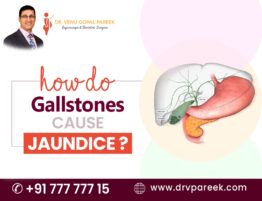
Gallstones, which may develop in the gallbladder or other areas of the biliary tract, are tiny, solid deposits of cholesterol and bile salts that can block the natural flow of bile. The gallbladder, located on the right side of your abdomen just beneath the liver, is a small organ with the main function of storing and concentrating a digestive liquid called bile. This bile is produced in the liver. Cholelithiasis refers to the presence of gallstones in the gallbladder, and if the stones form in the common bile ducts, it results in choledocholithiasis.
Gall stones formation is not limited to the gallbladder alone; occasionally, they can also develop outside the gallbladder, such as in the liver, pancreas, and surrounding bile ducts.
However, for a permanent solution to get rid of gallstones, some people opt to undergo gallbladder removal surgery, known as cholecystectomy. Dr. Venugopal Pareek, one of the laparoscopic surgeons in Hyderabad, is an expert in performing open cholecystectomy or laparoscopic cholecystectomy in Hyderabad. Call +91 91-777-77715 to book your consultation with the doctor.
Can you get a bile duct stone without a gallbladder?
Yes, in some rare cases, even after removing the gallbladder, there are possibilities of forming gallstones or bile duct stones outside the gallbladder. The liver, pancreas, and surrounding bile ducts are the places where doctors often diagnose stones.
Some people may develop a medical condition known as post-cholecystectomy syndrome after undergoing a cholecystectomy (gallbladder removal operation). People with this syndrome might experience symptoms like abdominal pain, indigestion, bloating, and developing stones in other areas like bile ducts.
The stones that are formed following the removal of the gallbladder in the bile ducts are commonly known as retained or residual bile duct stones. One of the rare and frequent side effects that can appear in some individuals following gallstone removal surgery is recurrent bile duct stones, with an incidence ranging from 4% to 24%.
These stones might be leftovers from the gallbladder, or they might be newly developed stones within the bile ducts.
Some of the causes of gallstones are as follows:
The liver still produces bile, which is necessary for fat digestion, even though there is no gallbladder. Usually, the gallbladder is used to store bile and release it when necessary, but now without the gallbladder, the bile released from the liver directly flows into the small intestine through the common bile ducts. Because of this, gallstones can develop anywhere along the bile duct system.
Residual stones — During the cholecystectomy treatment, some small gallstones may have been left in the bile ducts, which can eventually cause the development of new stones.
Bile stasis — As the gallbladder is removed, the function of storing and releasing bile timely is lost, which means that the continuous flow of bile through the ducts can become slow or stagnant, leading to an increased concentration of bile and promoting the formation of stones.
Biliary sludge — Over time, bile can become supersaturated with cholesterol or other components, resulting in the formation of biliary sludge, which may eventually improve the risk of forming gallstones.
Narrowing bile ducts — The risk of forming gallstones increases if the bile ducts become narrow or obstructed by any other underlying condition.
Altered bile composition — The composition of bile might be changed after removing the gallbladder, which increases the risk of gallstone formation.
Prompt medical attention is essential if you suspect or are diagnosed with bile duct stones after a cholecystectomy.
What are the symptoms of bile duct stones that form after gallbladder removal?
People with both an intact gallbladder and those who have undergone surgery to remove it may experience common signs and symptoms that indicate the presence of common bile duct stones.
The following are the symptoms:
- Abdominal pain
- Jaundice
- Nausea
- Vomiting
- Fever
- Cholangitis
- Pancreatitis
- High levels of bilirubin or liver enzymes.
The medical term for the development of gallstones is cholelithiasis if they occur in the gallbladder, and choledocholithiasis if they occur in the common bile ducts.
The treatment options for removing gallstones might include endoscopic procedures or other surgical procedures in more severe cases. In case you have any concerns or have any symptoms related to gallstones following gallbladder removal, it is important to consult the doctor so that he can perform a thorough evaluation and manage to prevent future complications.
For more detailed information about treatment for gallstones that appear post cholecystectomy, consult Dr. Venugopal Pareek, one of the best doctors for gallstone treatment in Hyderabad.







